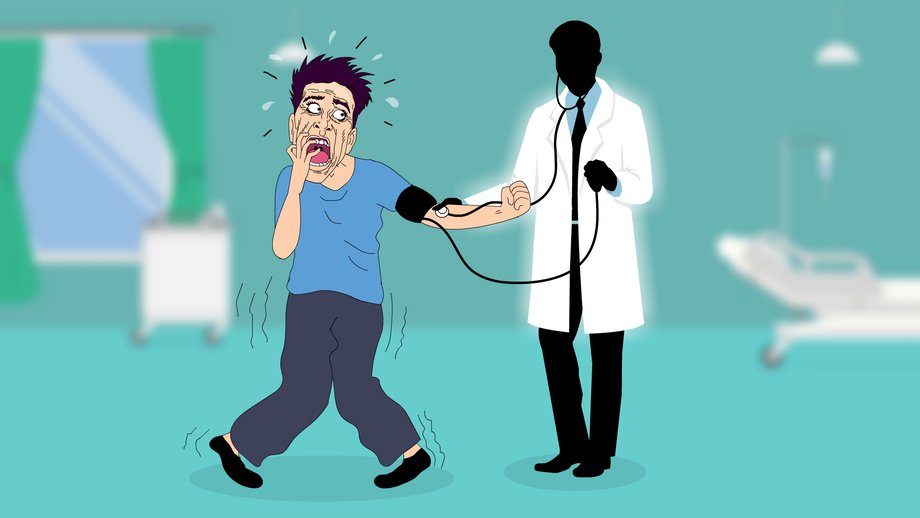What Is White-Coat Hypertension And How To Manage It?

White-coat hypertension is a phenomenon characterized by elevated blood pressure readings in a clinical setting, which may not accurately reflect an individual’s true blood pressure outside of the medical environment. This condition is of particular concern as it can lead to unnecessary medical interventions and increased anxiety in patients. Understanding the definition, causes, symptoms, and potential risks associated with white-coat hypertension is crucial for effective management and prevention.
This article aims to provide an objective and impersonal overview of white-coat hypertension, focusing on techniques to manage and reduce this condition. It will emphasize the importance of effective communication with healthcare providers and highlight the significance of lifestyle modifications in managing white-coat hypertension. By exploring these aspects, individuals can gain knowledge about managing this condition and improve their long-term prognosis.
Key Takeaways
- White-coat hypertension is defined as elevated blood pressure readings in a clinical setting, but normal blood pressure outside of the doctor’s office.
- Regular medication usage is important for controlling blood pressure in individuals with white-coat hypertension.
- Monitoring blood pressure regularly is essential to assess the effectiveness of medication and ensure proper management of white-coat hypertension.
- Lifestyle modifications such as exercise, maintaining a healthy diet, reducing sodium intake, managing stress, and weight management play a crucial role in managing white-coat hypertension.
Definition and Explanation of White-Coat Hypertension
White-coat hypertension refers to a phenomenon in which individuals exhibit elevated blood pressure readings in a clinical setting, but normal blood pressure levels outside of the clinical environment.
This condition is often attributed to the anxiety and stress associated with medical appointments, leading to a temporary increase in blood pressure.
It is estimated that around 20% of individuals diagnosed with hypertension may actually have white-coat hypertension.
The misdiagnosis of white-coat hypertension can have significant implications on treatment decisions. Patients who are misdiagnosed with hypertension may be unnecessarily prescribed antihypertensive medications, which can result in potential side effects and increased healthcare costs. Furthermore, misdiagnosis may lead to unnecessary lifestyle modifications and psychological distress for patients.
Therefore, accurate identification and management of white-coat hypertension is crucial to avoid unnecessary treatment interventions.
Causes and Factors that Contribute to White-Coat Hypertension
Physiological reactions triggered by the presence of medical professionals in a clinical setting could contribute to elevated blood pressure readings in individuals with white-coat hypertension. This phenomenon, commonly known as the white-coat effect, occurs due to anxiety and stress experienced by patients during medical appointments. The fear of being in a medical environment and the anticipation of negative outcomes can lead to temporary spikes in blood pressure.
Additionally, patient characteristics such as age, gender, and previous experiences with healthcare may also play a role in the development of white-coat hypertension. Other contributing factors include the individual’s perception of the healthcare system, their level of trust in medical professionals, and their overall anxiety levels.
Understanding these causes and factors is crucial in effectively managing white-coat hypertension and differentiating it from sustained hypertension.
Symptoms and Diagnosis of White-Coat Hypertension
Symptoms and diagnosis of white-coat hypertension can be identified through a combination of blood pressure measurements taken outside of the clinical setting, along with the patient’s self-reported symptoms and medical history. Accurate diagnosis is crucial as it distinguishes white-coat hypertension from sustained hypertension, which requires treatment.
Blood pressure monitoring over a 24-hour period, known as ambulatory blood pressure monitoring (ABPM), is considered the gold standard for diagnosing white-coat hypertension. ABPM allows for multiple blood pressure readings to be taken throughout the day, providing a more comprehensive assessment of the patient’s blood pressure levels. Additionally, self-monitoring at home using a validated blood pressure monitor can also aid in diagnosis accuracy.
Once diagnosed, treatment options for white-coat hypertension mainly focus on lifestyle modifications, such as reducing stress, maintaining a healthy weight, engaging in regular physical activity, and following a balanced diet low in sodium and alcohol intake. In some cases, medication may be prescribed if lifestyle changes alone are insufficient.
Potential Risks and Complications
Potential risks and complications associated with white-coat hypertension include the misclassification of patients as having sustained hypertension, leading to unnecessary treatment and potential side effects of medication.
White-coat hypertension is characterized by high blood pressure readings in a clinical setting but normal blood pressure outside of the medical environment. This discrepancy can result in a false diagnosis of hypertension, leading to unnecessary treatment with antihypertensive medications. This can expose patients to potential side effects of these medications, such as dizziness, fatigue, and sexual dysfunction.
Additionally, misdiagnosis may lead to unnecessary lifestyle modifications and increased healthcare costs. Furthermore, the anxiety and stress associated with medical settings can exacerbate blood pressure readings, leading to a heightened risk of overestimating the severity of hypertension and initiating unnecessary interventions.
Therefore, healthcare professionals should be cautious in diagnosing and managing white-coat hypertension to avoid these potential risks and complications.
Techniques to Manage and Reduce White-Coat Hypertension
This paragraph introduces a discussion on techniques to manage and reduce white-coat hypertension. These techniques include relaxation and breathing exercises, home blood pressure monitoring, and medication management.
These techniques are important for individuals with white-coat hypertension as they can help reduce anxiety and promote relaxation. They also provide a more accurate picture of blood pressure levels outside of the clinical setting. Additionally, these techniques ensure that medications are being used effectively and appropriately.
By incorporating these techniques into their daily routine, individuals with white-coat hypertension can better manage their condition and improve their overall cardiovascular health.
Relaxation and Breathing Exercises
Relaxation and breathing exercises are effective techniques that can be utilized to manage white-coat hypertension and promote a sense of calmness and relaxation. Deep breathing exercises involve taking slow, deep breaths and exhaling slowly, which helps to lower blood pressure and reduce stress. Progressive muscle relaxation, on the other hand, involves tensing and then releasing different muscle groups in the body, promoting a state of deep relaxation. These techniques can be practiced regularly to help individuals cope with the anxiety and stress associated with white-coat hypertension. By incorporating these exercises into their daily routine, individuals may experience a decrease in blood pressure readings during medical appointments, leading to a more accurate diagnosis of their true blood pressure levels. The following table provides a visual representation of the techniques mentioned:
| Techniques | Description |
|---|---|
| Deep breathing exercises | Involves slow, deep breaths and slow exhalation to lower blood pressure |
| Progressive muscle relaxation | Involves tensing and releasing different muscle groups to promote relaxation |
Home Blood Pressure Monitoring
Home blood pressure monitoring is a reliable method for individuals to track their blood pressure levels in the comfort of their own homes. It allows for regular monitoring and provides valuable information for blood pressure control.
By measuring blood pressure at different times throughout the day, individuals can gain a better understanding of their blood pressure patterns and identify any potential fluctuations. This knowledge can help in the management of white-coat hypertension, a condition where blood pressure readings are higher in a clinical setting compared to home measurements.
Home blood pressure monitoring can also facilitate self-care strategies by empowering individuals to take an active role in their health. By regularly monitoring their blood pressure and following self-care measures such as a healthy diet, regular exercise, and stress reduction techniques, individuals can effectively manage their blood pressure levels and promote overall cardiovascular health.
Medication Management
Medication management plays a crucial role in controlling blood pressure levels and promoting cardiovascular health. To effectively manage white-coat hypertension, it is important to consider the effectiveness of medications and explore alternative treatments. Here are some key points to consider:
- Regular medication usage: Consistency is essential in maintaining blood pressure control. It is important to take prescribed medications as directed by the healthcare provider.
- Monitoring medication effectiveness: Regular blood pressure monitoring helps assess the effectiveness of the prescribed medications. This enables adjustments to the medication regimen if necessary.
- Lifestyle modifications: Alongside medication, adopting a healthy lifestyle is vital. This includes regular exercise, a balanced diet, reduced sodium intake, limited alcohol consumption, and weight management.
- Stress management: Stress can contribute to increased blood pressure. Employing stress-reducing techniques such as meditation, deep breathing exercises, or engaging in hobbies can help manage blood pressure levels.
- Alternative treatments: Some individuals may explore complementary and alternative therapies, such as acupuncture, herbal supplements, or relaxation techniques. However, it is crucial to consult with a healthcare provider before incorporating these treatments into the management plan.
By implementing these strategies, individuals with white-coat hypertension can effectively manage their condition and promote better cardiovascular health.
Communication with Healthcare Providers
Effective communication with healthcare providers is crucial in managing white-coat hypertension, ensuring accurate diagnosis, and optimizing treatment strategies. Building trust between patients and healthcare providers is fundamental to establish a cooperative relationship that promotes open dialogue.
Patients should feel comfortable expressing their concerns, asking questions, and providing accurate information about their symptoms and medical history. This trust facilitates the accurate diagnosis of white-coat hypertension, as patients may experience anxiety or stress during medical appointments, leading to elevated blood pressure readings.
Moreover, effective communication enables patient education, allowing individuals to understand the nature of their condition, its potential consequences, and the importance of adhering to the prescribed treatment plan. By actively engaging in discussions with healthcare providers, patients can actively participate in decisions regarding their care, leading to improved management of white-coat hypertension.
Importance of Lifestyle Changes
This discussion will focus on the importance of lifestyle changes in managing white-coat hypertension.
Two key points that will be explored are healthy diet and exercise, as well as stress management techniques.
These lifestyle modifications have been shown to have a significant impact on reducing blood pressure levels and improving overall cardiovascular health.
Healthy Diet and Exercise
Implementing a well-balanced diet and engaging in regular physical activity are key components in managing white-coat hypertension.
Healthy eating plays a crucial role in maintaining blood pressure levels within a healthy range. A diet rich in fruits, vegetables, whole grains, and low-fat dairy products is recommended. These foods are low in sodium and high in potassium, which helps to lower blood pressure. Additionally, limiting the intake of saturated and trans fats, cholesterol, and added sugars is important.
Regular physical activity is equally important in managing white-coat hypertension. Engaging in aerobic exercise, such as brisk walking, jogging, or cycling, for at least 150 minutes per week can significantly reduce blood pressure. Strength training exercises, such as lifting weights, can also be beneficial.
Combining a healthy diet with regular exercise can effectively manage white-coat hypertension and improve overall cardiovascular health.
Stress Management Techniques
One important aspect in the management of white-coat hypertension involves adopting stress management techniques that can help individuals maintain optimal blood pressure levels.
To reduce stress and manage white-coat hypertension effectively, individuals can try incorporating the following stress reduction techniques into their daily routine:
- Mindfulness meditation: Practicing mindfulness techniques, such as deep breathing exercises and focusing on the present moment, can help reduce stress and promote relaxation.
- Physical activity: Engaging in regular exercise, such as walking, swimming, or yoga, can help relieve stress and improve overall cardiovascular health.
- Relaxation techniques: Trying relaxation techniques like progressive muscle relaxation or guided imagery can aid in reducing anxiety and lowering blood pressure.
- Time management: Learning effective time management skills and prioritizing tasks can help reduce stress levels and prevent the onset of white-coat hypertension.
By implementing these stress management techniques, individuals with white-coat hypertension can better manage their condition and maintain healthy blood pressure levels.
Long-Term Outlook and Prognosis for White-Coat Hypertension
The long-term prognosis for individuals with white-coat hypertension remains uncertain, as more research is needed to fully understand the potential risks and complications associated with this condition.
White-coat hypertension is characterized by elevated blood pressure readings in a clinical setting, while blood pressure remains within normal limits in other situations. It is important to note that white-coat hypertension is not benign, as it has been associated with an increased risk of developing sustained hypertension and cardiovascular disease. However, the long-term effects of white-coat hypertension on overall health and mortality rates are still unclear.
Treatment options for white-coat hypertension typically involve lifestyle modifications, such as regular exercise, a healthy diet, and stress management techniques. In some cases, medication may be prescribed to control blood pressure.
Further research and long-term studies are necessary to determine the true impact and prognosis of white-coat hypertension.
Frequently Asked Questions
Can white-coat hypertension lead to long-term health problems?
White-coat hypertension, characterized by elevated blood pressure readings in medical settings, is not associated with long-term health problems. However, the anxiety induced by medical visits may have short-term effects on blood pressure measurements.
Are there any specific medications that can help manage white-coat hypertension?
Medication options for managing white-coat hypertension include beta-blockers, calcium channel blockers, and angiotensin receptor blockers. Alternative therapies such as relaxation techniques and lifestyle modifications can also be considered as adjunctive treatments.
How often should blood pressure measurements be taken to accurately diagnose white-coat hypertension?
Blood pressure measurements should be taken frequently to accurately diagnose white-coat hypertension. Regular monitoring ensures accurate assessment of blood pressure levels and helps differentiate between elevated readings caused by anxiety in medical settings and true hypertension.
Is it possible to completely eliminate white-coat hypertension through lifestyle changes alone?
Eliminating white-coat hypertension through lifestyle modifications alone is possible. Non-pharmacological interventions such as stress reduction techniques, regular exercise, a healthy diet, and limiting alcohol and caffeine intake can help manage this condition effectively.
Are there any alternative therapies or treatments that can be used to manage white-coat hypertension?
Alternative therapies and non-pharmaceutical treatments can be employed to manage white-coat hypertension. These approaches may include relaxation techniques, biofeedback, acupuncture, and herbal supplements. However, further research is needed to evaluate their effectiveness in this specific condition.








